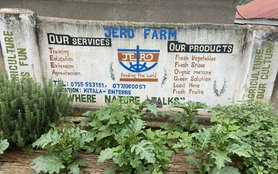Regenerative agriculture briefly claimed the spotlight on the world stage this year.
When US Secretary of State Antony Blinken spoke at the World Economic Forum in January, it was to realign the past, present, and future of agriculture.
Out with the Green Revolution—nearly half a century of investment in high-yield seeds, monoculture, irrigation, mechanization, and chemical fertilizers and pesticides —and in with an approach that Blinken termed “truly revolutionary.”
While the Green Revolution is credited with improving yields and in turn, food security, the gains were unsustainable because the methods were so damaging to the soil and the environment.
The alternative the US is now promoting, known as regenerative agriculture, prioritizes soil health and crop diversity. Instead of monocropping maize, wheat, and rice, smallholder farmers engaged in regenerative agriculture grow a mix of traditional crops like cassava, cowpeas, and millet, which are nutritious and better adapted to the changing climate. Methods of protecting and improving soil health include planting cover crops and minimizing tilling—techniques that also reduce costs, in terms of both money and carbon.
It’s an approach that draws on traditional and indigenous farming practices, and on the notion that when it comes to agriculture, it is wiser to work with nature than against it.
If this sounds like utopian thinking, disconnected from the real world of markets and bottom lines, think again: major food, beverage, and agriculture companies are leaning into regenerative agriculture as a means of reducing their carbon footprints.
Blinken’s message was welcome, and so is the fact that the Biden Administration is putting some of its resources behind its rhetoric. The US aims to spend USD 150 million to jumpstart this shift—a small sum, but one that follows a commitment of USD 17 billion made at COP 28 last year to regenerate degraded crop land and capture carbon in soil.
Greenwashing won’t do
As soon as corporate PR comes on the scene, greenwashing is rarely far behind, with the half-baked efforts and inflated claims we’ve come to expect. As are practices that prioritize profits over the needs and rights of people who struggle with poverty and who may not feel safe to speak out for their families and communities. So, here is what companies and other stakeholders should do as they engage with farmers in this important effort:
- Center smallholders in the conversation. Small-scale farmers feed a third of the world’s population, and regenerative agriculture is predicated on the wisdom of their practices. Their perspectives are crucial to the success of this shift, and their interests need to be placed front and center. As Oxfam’s report “Tightening the Net” cautions, where companies use land- and nature-based solutions for climate mitigation, they must put strong social safeguards in place, and prioritize the livelihoods and food security of smallholder farmers.
- Land security is essential. Regenerative agriculture requires investing in the long-term health of the land. Smallholder farmers may be reluctant to do so, however, unless they can be confident that that land will be theirs for decades to come. Nearly 90 percent of land in Africa remains undocumented; recent surveys reveal that many smallholder farmers worry they will lose their land and are therefore discouraged from making that investment. Complex issues like land security and tenure require private and public sectors to work together for solutions that benefit small-scale producers.
- Establish learning spaces. Regenerative agriculture may include traditional practices, but it is still new to many public- and private-sector stakeholders. Sharing data, insights, and best practices is essential.
Regenerative agriculture is having a moment. Let’s use it to build momentum for this new-old approach and be sure it gets on the right track.



